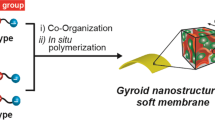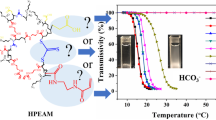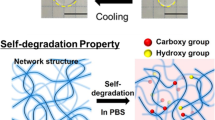Abstract
Amphiphilic peptides consisting of an alternating binary pattern of repeating hydrophilic and hydrophobic units were synthesized via polymerization exploiting Ugi’s four-component condensation reaction (Ugi’s 4CC) as the fundamental polymerization reaction. We performed turbidity measurements of the aqueous polymer solutions at various temperatures. The results showed that the structural effects of the alternating peptides had the following impacts on thermoresponsiveness: (i) amphiphilic alternating peptides with repeating hydrophilic and hydrophobic units tended to adopt upper critical solution temperature (UCST) behavior; and (ii) when the hydrophobes in the polymer were large enough for intrachain hydrophobic interactions, the polymer displayed lower critical solution temperature (LCST) behavior. In addition, we prepared thermoresponsive hydrogels comprising poly(N,N-dimethylacrylamide) as the main chain with alternating peptide skeletons as the cross-linking points. The swellability of the hydrogels in water was clearly dependent on temperature, indicating that the thermal transition of the alternating peptides as the cross-linking points led to the hydrogel volume change. Alternating peptides with LCST behavior may be useful for creating peptide-based smart materials in the future.
This is a preview of subscription content, access via your institution
Access options
Subscribe to this journal
Receive 12 print issues and online access
$259.00 per year
only $21.58 per issue
Buy this article
- Purchase on Springer Link
- Instant access to full article PDF
Prices may be subject to local taxes which are calculated during checkout






Similar content being viewed by others
References
Danielli F, de Sousa B. The role of plastic concerning the sustainable development goals: the literature point of view. Clean Respons Consum. 2021;3:100020/1–24.
Walker TR. (Micro)plastics and the UN sustainable development goals. Curr Opin Green Sust Chem. 2021;30:100497/1–9.
van Hest JCM. Biosynthetic-synthetic polymer conjugates. J Macromol Sci, Part C: Polym Rev. 2007;47:63–92.
Deming TJ. Polypeptide materials. New synthetic methods and applications. Adv Mater. 1997;9:299–311.
Deming TJ. Synthesis of side-chain modified polypeptides. Chem Rev. 2016;116:786–808.
Smith LA, Ma PX. Nano-fibrous scaffolds for tissue engineering. Colloids Surf B. 2004;39:125–31.
Sell SA, McClure MJ, Garg K, Wolfe PS, Bowlin GL. Electrospinning of collagen/biopolymers for regenerative medicine and cardiovascular tissue engineering. Adv Drug Deliv Rev. 2009;61:1007–19.
Lee TAT, Cooper A, Apkarian RP, Conticello VP. Thermo-reversible self-assembly of nanoparticles derived from elastin-mimetic polypeptides. Adv Mater. 2000;12:1105–10.
Chilkoti A, Dreher MR, Meyer DE, Raucher D. Targeted drug delivery by thermally responsive polymers. Adv Drug Deliv Rev. 2002;54:623–30.
Bidwell GL, Fokt I, Priebe W, Raucher D. Development of elastin-like polypeptide for thermally targeted delivery of doxorubicin. Biochem Pharmacol. 2007;73:620–31.
Trabbic-Carlson K, Setton LA, Chilkoti A. Swelling and mechanical behaviors of chemically cross-linked hydrogels of elastin-like polypeptides. Biomacromolecules. 2003;4:572–80.
Chin SM, Synatschke CV, Liu S, Nap RJ, Sather NA, Wang Q, et al. Covalent-supramolecular hybrid polymers as muscle-inspired anisotropic actuators. Nat Commun. 2018;9:2395/1–11.
Lim DW, Nettles DL, Setton LA, Chilkoti A. Rapid cross-linking of elastin-like polypeptides with (hydroxymethyl)phosphines in aqueous solution. Biomacromolecules. 2007;8:1463–70.
Balu R, Dutta NK, Dutta AK, Choudhury NR. Resilin-mimetics as a smart biomaterial platform for biomedical applications. Nat Commun. 2012;12:149/1–15.
Hu R, Li W, Tang BZ. Recent advances in alkyne-based multicomponent polymerizations. Macromol Chem Phys. 2016;217:213–24.
Zhang Z, You Y, Hong C. Multicomponent reactions and multicomponent cascade reactions for the synthesis of sequence-controlled polymers. Macromol Rapid Commun. 2018;39:1800362/1–12.
Kakuchi R. Multicomponent reactions in polymer synthesis. Angew Chem, Int Ed. 2014;53:46–48.
Tao Y, Tao Y. Ugi reaction of amino acids: From facile synthesis of polypeptoids to sequence-defined macromolecules. Macromol Rapid Commun. 2021;42:2000515/1–9.
Dömling A, Ugi I. Multicomponent reactions with isocyanides. Angew Chem, Int Ed. 2000;39:3168–210.
Ugi I, Werner B, Dömling A. The chemistry of isocyanides, their multicomponent reactions and their libraries. Molecules. 2003;8:53–66.
Sharma UK, Sharma N, Vachhani DD, van der Eycken EV. Metal-mediated post-Ugi transformations for the construction of diverse heterocyclic scaffolds. Chem Soc Rev. 2015;44:1836–60.
Koyama Y, Gudeangadi PG. One-pot synthesis of alternating peptides exploiting a new polymerization technique based on Ugi’s 4CC reaction. Chem Commun. 2017;53:3846–9.
Ihsan AB, Koyama Y. Impact of polypeptide sequence on thermal properties for diblock, random, and alternating copolymers containing a stoichiometric mixture of glycine and valine. Polymer. 2019;161:197–204.
Ihsan AB, Nargis M, Koyama Y. Effects of the hydrophilic-lipophilic balance of alternating peptides on self-assembly and thermo-responsive behaviors. Int J Mol Sci. 2019;20:4604/1–11.
Li W, Chung H, Daeffler C, Johnson JA, Grubbs RH. Application of 1H DOSY for facile measurements of polymer molecular weights. Macromolecules. 2012;45:9595–603.
Campbell DS. Structural characterization of vulcanizates. 11. Network-bound accelerator residues. J Appl Polym Sci. 1970;14:1409–19.
Gundogan N, Okay O, Oppermann W. Swelling, elasticity and spatial inhomogeneity of poly(N,N-dimethylacrylamide) hydrogels formed at various polymer concentrations. Macromol Chem Phys. 2004;205:814–23.
Orakdogen N, Okay O. Reentrant conformation transition in poly(N,N-dimethylacrylamide) hydrogels in water-organic solvent mixtures. Polymer. 2006;47:561–8.
Oh H, Joo MK, Sohn YS, Jeong B. Secondary structure effect of polypeptide on reverse thermal gelation and degradation of L/DL-poly(alanine)-poloxamer-L/DL-poly(alanine) copolymers. Macromolecules. 2008;41:8204–9.
Cheng Y, He C, Xiao C, Ding J, Zhuang X, Huang Y, et al. Decisive role of hydrophobic side groups of polypeptides in thermosensitive gelation. Biomacromolecules. 2012;13:2053–9.
Griffin WC. Classification of surface-active agents by “HLB”. J Soc Cosmet Chem. 1949;1:311–26.
Mergny JL, Lacroix L. Analysis of thermal melting curves. Oligonucleotides. 2003;13:515–37.
Jang K, Iijima K, Koyama Y, Uchida S, Asai S, Takata T. Synthesis and properties of rotaxane-cross-linked polymers using a double-stranded γ-CD-based inclusion complex as a supramolecular cross-linker. Polymer. 2017;128:379–85.
Functional polymers by post-polymerization modification: concepts, guidelines and applications. Eds: Theato P, Klok HA Wiley-VCH, New York, 2012.
Blasco E, Sims MB, Goldmann AS, Sumerlin BS, Barner-Kowollik C. 50th anniversary perspective: polymer functionalization. Macromolecules. 2017;50:5215–52.
Gauthier MA, Gibson MI, Klok HA. Synthesis of functional polymers by post-polymerization modification. Angew Chem Int Ed. 2009;48:48–58.
Nair DP, Podgórski M, Chatani S, Gong T, Xi W, Fenoli CR, et al. The thiol-Michael addition click reaction: a powerful and widely used tool in materials chemistry. Chem Mater. 2014;26:724–44.
Das A, Theato P. Activated ester containing polymers: opportunities and challenges for the design of functional macromolecules. Chem Rev. 2016;116:1434–95.
Sruthi PR, Anas S. An overview of synthetic modification of nitrile group in polymers and applications. J Polym Sci. 2020;58:1039–61.
Sada K, Takeuchi M, Fujita N, Numata M, Shinkai S. Post-polymerization of preorganized assemblies for creating shape-controlled functional materials. Chem Soc Rev. 2007;36:415–35.
As for Ref-Gel, the hydrophobic structures at the cross-linking points are sparsely located in the hydrogel, which can contribute on the UCST behaviors. For a related report, see: Taylor M. J, Tomlins P, Sahota T. S. Thermoresponsive gels. Gels, 2017; 3;4/1–31.
Acknowledgements
This work was supported by the Ogasawara Toshiaki Memorial Foundation.
Author information
Authors and Affiliations
Corresponding author
Ethics declarations
Conflict of interest
The authors declare no competing interests.
Additional information
Publisher’s note Springer Nature remains neutral with regard to jurisdictional claims in published maps and institutional affiliations.
Supplementary information
Rights and permissions
About this article
Cite this article
Komuro, N., Nakajima, N., Hamada, M. et al. Design and synthesis of amphiphilic alternating peptides with lower critical solution temperature behaviors. Polym J 54, 903–912 (2022). https://doi.org/10.1038/s41428-022-00639-7
Received:
Revised:
Accepted:
Published:
Issue Date:
DOI: https://doi.org/10.1038/s41428-022-00639-7



